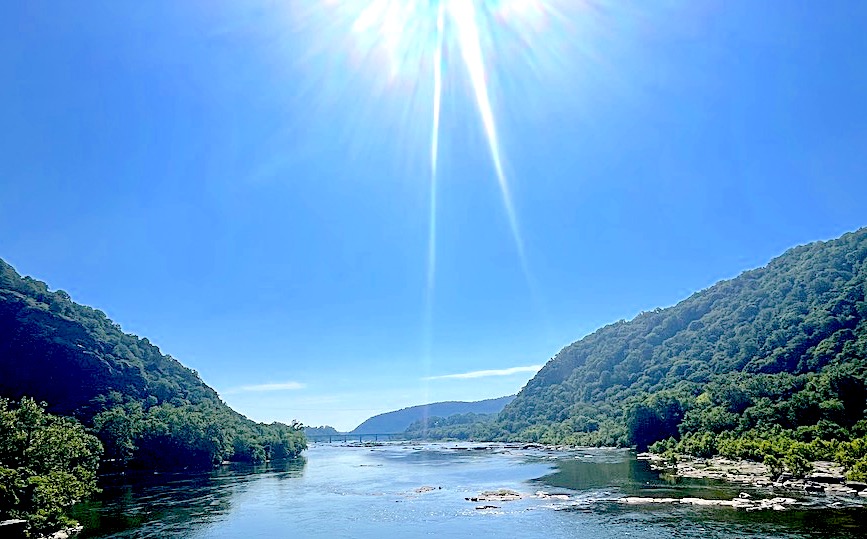Harpers Ferry, West Virginia is a unique place. The area between Gettysburg, Philadelphia, Richmond and the Shenandoah Valley is home to hundreds of historical sites. Even with much to see nearby, Harpers Ferry stands out for its history and its scenic beauty and recreation.
Whether you only want to spend an hour or so on an easy hike or plan a full week of camping, paddling, and outdoor activities, the confluence of the the Shenandoah and Potomac is a scene that’s rare in the East. It rivals anything you could see in Colorado, Idaho or Washington while still being easy to reach from anywhere along the East Coast.





Where’s the Money? This site may contain affiliate links. Many travel sites include such links to earn a commission at no cost to readers.
Why is the Town Here?
In the age of highways it’s easy to forget that crossing a mountain with no road is incredibly difficult. If you’re plodding along on foot or with a few horses, following a river is almost always the easiest path. That’s why the water flows that way in the first place. The entire history of westward expansion is nothing more than an attempt to connect one river’s watershed to the next. Reaching the Ohio River Valley was the first major accomplishment. Chicago was built where it is because you can carry a canoe overland from Lake Michigan to the Des Plaines River. From there it’s possible to reach the Mississippi. After the settlement of Chicago the circuit by water from the Northeast was complete.
The ferry operation was in place between Maryland and Virginia as early as 1733. The point was a natural choice for manufacturing in the days when mills ran on the power of flowing water. But proximity upriver from Washington DC has always been the defining feature of Harpers Ferry. Even today highways and commuter rail run in this direction. The area is home to bedroom communities for people who commute or retire from Washington.
It was 1783 when Thomas Jefferson visited and looked over the valley from the rock that bears his name now. He declared the scenery as being worth a trip across the Atlantic to see. Shortly after Jefferson’s visit George Washington explored the area and selected it for purchase to establish the federal armory. It proved easy to move men and material to DC. The site was remote enough that it was never attacked by the British in the course of two subsequent wars.






John Brown’s Raid on Harpers Ferry in 1859
In October 1859, approximately 18 months before the first shot rang out at Fort Sumpter, John Brown attempted to occupy the federal arsenal at Harpers Ferry. The raid was in furtherance of a wider slave revolt throughout Virginia and the southern Appalachians. It’s not an exaggeration to say that this is one of the most important events in American history. Any timeline of the Civil War that fails to include it is noticeably incomplete. But it’s not necessary to take my word for it.
May 30, 1881
“…but John Brown, began the war that ended American slavery and made this a free Republic. Until this blow was struck, the prospect for freedom was dim, shadowy and uncertain. The irrepressible conflict was one of words, votes and compromises.”
Then-US Colonel Robert E. Lee’s men captured Brown on the second day after his raid began. He was hanged in nearby Charles Town two months after that. Brown is remembered by History as a martyr for the abolition of Slavery and a great American hero.
The engine house seen above was part of the armory complex. It’s the place where federal troops besieged Brown’s men and hostages for around 36 hours. In my estimation this site is holier than a thousand churches. It’s more important than any monument or land-grant university you care to name.
John Brown’s Legacy
Any number of books are available about the life of John Brown and the events surrounding his raid. Two that are worth considering are the Biography by W.E.B. DuBois and the National Park Service account of the raid.
Almost immediately after his death US soldiers began to sing the anthem John Brown’s Body. In 1861 the poet Julia Ward Howe used Brown’s anthem as the basis for the Battle Hymn of the Republic. That version became the marching song for the entire union army. It’s one of the most stirring and important songs of our nation. The lyrics say fairly explicitly that the cause of abolition is righteous and that God himself supports the Union.
There’s a museum dedicated to Brown across from the site of his fort as well as a wax museum in the town. John Brown’s final resting place is on his farm near Lake Placid, New York. That property is now a state park and historical site devoted to Brown’s legacy.

Civil War History at Harpers Ferry
For those interested in Civil War history this area is the best in the country. Gettysburg is only one hour from Harpers Ferry by car. Winchester is 40 minutes. Antietam and Monocacy are 30 minutes. There are dozens of other sites easily reachable by car from where these three states meet.
Before the war started in earnest US troops burned the arsenal and armory to prevent its seizure by the confederacy. Nevertheless several battles were fought in the vicinity of the town. It’s location on the railroad at a mountain pass meant it remained crucially important even without the armory. The exact events of the war are beyond the scope of this post. Visitors can discover or research them easily enough.
Even for those not particularly interested in the details of battles the well-preserved battlefields at Bolivar Heights provide a gorgeous view of the natural scenery. The battlefield is a short drive uphill from the town and any visit to the area would be incomplete without at least a quick visit to the battlefield.




Hiking and Recreation
The most popular outdoor activity in Harpers Ferry is also the simplest. There’s a trail for all hiking abilities here whether you want to go a thousand miles over mountains or just take a 20 minute walk in a flat and shaded area along the river.
The Appalachian Trail Conservancy Headquarters is in town. The visitor center there can answer everything you want to know about the trail. There’s a hiker’s lounge inside and information on trails all over the area, not just the Appalachian Trail.
The area is not good for swimming but every other sort of river recreation is easy to find. There are points along the highway where paddlers are invited to unload their own gear. Those without gear or the experience to negotiate moderate rapids can find many options for rentals or guided trips online. You can fish right from the park but buying a WV fishing license is required.
The National Park Service has a detailed guide for camping on federal land. There are some commercial options in the area as well with the easiest option being a KOA in Charles Town right off the highway. It offers RV sites, Tent Sites, and cabins with amenities like a pool, mini golf, arcade and dog park.
Getting To and Staying In Harpers Ferry
If you’re not camping you’ll need to decide between a charming and historic vacation rental or a hotel. You can find lots of B&B’s, historic homes and cabins on sites like Expedia and Trivago. There are only about 3 restaurants in Harpers Ferry proper and they all close early. So while a historic house or B&B might be appealing the town is eerily quiet at night and there’s not an advantage to staying inside the lower town or in Boliver.
Most hotels are just a few miles away in Charles Town. Many options are noticeably downscale. Your best bets for a stay here are going to be the Hampton Inn, the Home2 Suites by Hilton or the Holiday Inn Express. There’s also a new Holiday Inn Express very close to Harpers Ferry in Brunswick, MD. I stayed at this location recently and posted a full review.
Most visitors are going to arrive by car. Parking is tight at Harpers Ferry. You can park at the visitors’ center which is two miles uphill from the lower town. Shuttle buses go into town continuously from there. You can also park in the small lot at the train station in town. Either way it’s $20 per car, but that gets you a pass good for three days. You can get it online, at the visitors’ center, or scan the QR code if you’re parking at the train station.
It is possible to arrive by train. Tickets are around $26 from Washington. But keep in mind that it’s commuter rail which means you’ll be arriving in Harpers Ferry in the evening and you’ll be compelled to leave very early in the morning to get back to DC. Coming by car is the better option.

Charles Town Races and Hollywood Casino
Many visitors to Harpers Ferry are going to be worn out after long days hiking and climbing hills. If you’re looking for nightlife in the area it pretty much begins and ends at the racetrack and casino. Personally I love horse racing whether it’s at Churchill Downs or halfway around the world in Hong Kong. Even if you’ve had zero exposure to the sport Charles Town is worth checking out. The vibes on the backstretch are very casual and a lot of local families spend their nights at the track. Plus the beer is cheap. Races are held year round, usually on Thursday, Friday and Saturday at 7:00 pm.
The casino is… well, it’s a casino. It benefits from the recent addition of a sports book area and there are some dining options inside. There’s an entertainment venue but it’s mostly musical acts that play to an older audience. Right now the calendar features Joan Jett, .38 Special and George Thorogood. But they sometimes book big name comedians as well. Dana Carvey, Tracey Morgan and Craig Ferguson are on the current schedule.
The attached hotel bills itself as “luxury” but it’s extremely difficult to determine anything luxurious about it. That is, other than the price tag. Even if you do want to spend a night playing races and slots you’ll do much better to select one of the hotels mentioned above.



















































